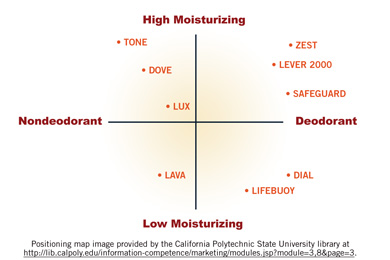In the first part of the positioning map discussion, I explained how a positioning map is a useful tool to identify brand perception. In this piece, I will explain how to create one and use it in your planning.
To create a positioning map as part of positioning strategy planning with internal audiences and to identify brand position:
- Develop a graph (a box divided into four squares) with two axes, an X and Y representing different attributes of a product.
- Choose the two attributes you feel are most relevant and important to your target audience, such as design and performance, color and taste, function and beauty, fuel economy and price, taste and healthiness. Notice that each end on the positioning map represents the extremes of each attribute.
- Plot where you think prospects and customers perceive your product on the positioning map. Is your product more functional than aesthetically pleasing? Cheap but not fuel-efficient? Reliable but not very sexy? Custom but not cheap? Tastes good but not healthy? This construct works for anything that can be "positioned," including a company, product, service, even an individual. It is sometimes helpful to use circles to represent each competitor on your positioning map, with larger circles representing market share. The bigger the circle, the greater the market share. This will help you to determine how to maneuver your brand marketing, offense, defense, flank, or guerilla, following the principles of Marketing Warfare.
By this point in the exercise, you will have visually mapped your brand, product or service relative to competition and attributes of importance to prospects and customers. The resulting positioning map will give your organization a clear snapshot of how well your position is or is not differentiated relative to competition. It will also provide a snapshot of the unmet or under-met market need representing the area of greatest opportunity for brand differentiation.
One caution - at this stage, your positioning map shows only what youassume your customers are thinking relative to your brand and competition. Obviously, this visualization needs to be validated by finding out what customers are actually thinking.
- Based on customer feedback, correct your perceptions of your brand's position. This is where you can use research to ask target audiences what they think of your brand based on the attributes you've chosen. Comparing the customer positioning map to your internal positioning map will tell you whether the external perceptions of customers align with your own internal perceptions for the brand.
- Finally, you may use a positioning map to find your brand gap. This is the gap between where your brand is perceptually on the map, and where you want it to be. The comparison between "held" and "desired" perceptions creates the gap that must be bridged (adjusted for) by your marketing effort, advertising, promotions, public relations, etc.
Below is another example of a positioning map from the Internet to help identify brand perception. Competition is more brutal than ever before. To be successful, your company must become competitor-oriented. Mapping competitive positions needs to become a priority part of any marketing plan (not something tucked away in the appendix). If you haven't included a positioning map in your strategic planning, try it. And let us know how it works for you.


Innis Maggiore's Appreciative Discovery works with clients to develop several positioning maps as a tool to find their brand differences. Discover how to make a positioning map and learn about our Appreciative Discovery session. Lorraine Kessler is Innis Maggiore's Principal Client Services & Positioning Strategist.



